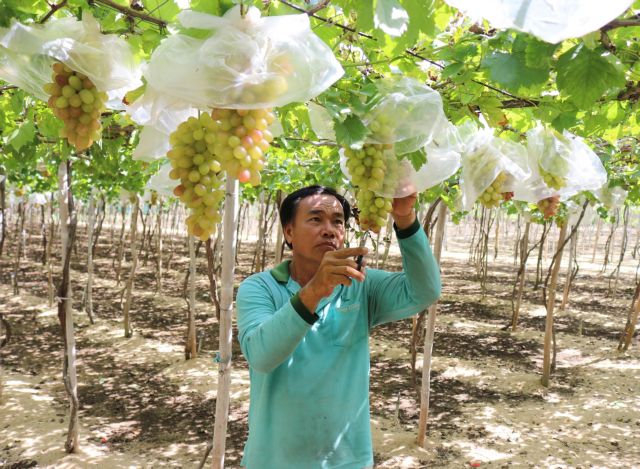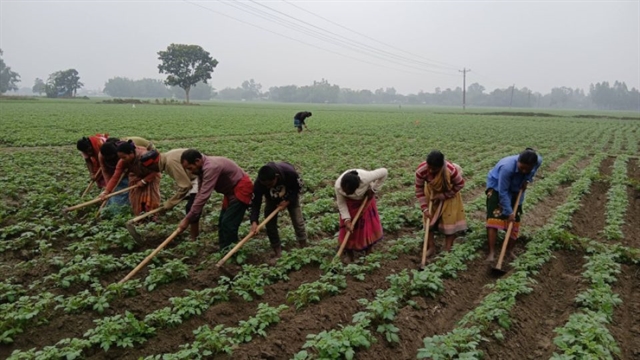 Society
Society

Agricultural production has been increasing in the south-central province of Ninh Thuận in recent years, thanks to the innovative Large Field Model (LFM).

|
| Trần Thái Truyện in his grape garden which is planted with modern planting techniques. — VNAA/VNS Photo Nguyễn Thành |
NINH THUẬN — Agricultural production has been increasing in the south-central province of Ninh Thuận in recent years, thanks to the innovative Large Field Model (LFM).
The production model uses scientific and technical advances to improve production efficiency while enhancing links between farmers, enterprises and cooperatives to ensure product consumption.
A grape-growing business ran by Trần Thái Truyện, in Vĩnh Hải Commune of Ninh Hải District, is a typical example of the successes reaped from LFM in production.
Truyện's family traditionally grew Red Cardinal grapes. When harvesting, Truyện always had to find traders to buy grapes.
“Traders always made excuses for low product quality and difficulties of the market to lower their prices. Production efficiency was low,” Truyện said.
In 2018, with help from the local government and Thái An Cooperative, his family began growing NH-01-152 grape varieties over an area of 2,000sq.m, as per LFM and Vietgap standards.
The cooperative supplied seedlings, planting and nursery techniques, as well as knowledge on how to economically water the crops and supported product consumption. Thanks to these efforts, the economic efficiency was better, Truyện said.
This grape variety has many outstanding advantages. It is a large firm fruit with thick skin, juicy flesh, moderate sweetness and a characteristic light aroma. Each bunch of grapes ranges from 0.5-1.5kg.
When this grape is ripe it has a beautiful red wine colour and is very popular in the market.
This grape variety, which can be harvested twice a year, gives a yield of 1-1.2 tonnes per 1,000sq.m per crop.
Normally, the grapes sell for VNĐ100,000-120,000 (US$4.4-5.2) per kilo.
Due to the impact of the COVID-19 pandemic for the last two years, the prices of grapes fell slightly to VNĐ80,000-90,000 ($3.5-3.9) per kilo. However, this price is still 4-5 times higher than traditional grape varieties, the farmer said.
After deducting investment costs, Truyện’s family still has a profit of over VNĐ50 million ($2,200) per 1,000sq.m per crop.
Nguyễn Khắc Phòng, Director of Thái An Cooperative, said it has 64 members participating in growing LFM production grapes over a total planting area of seven ha.
To improve production efficiency, the cooperative assisted members by supplying seedlings and agricultural materials, installing water-saving irrigation systems, and transferring science and technology, said Phòng.
The cooperative also signed contracts with fertiliser and plant substance protection companies to obtain the best prices for their members, Phòng said.
To ensure stable consumption, the cooperative signed contracts with each member or introduced reputable traders to farmers.
The cooperative is mobilising members to expand the cultivation areas of the NH 01-152 grape varieties, combined with an eco-tourism model to maximise profits, he said.
Like the grape farmers, the Raglai ethnic minorities in Phước Chính Commune of Bác Ái District have applied LFM techniques to their rice production.
The application has helped the farmers increase their incomes, thanks to land accumulation, mechanisation from sowing to harvesting and marketing more products.
According to Patau Asah Thị Dém, Secretary of the commune’s Party Committee, since 2020 the commune has carried out rice LFM projects in Phước Chính Commune. The projects involve 11 households over 4.6ha of land.
So far, the crops produced have brought higher economic value than the traditionally-produced style, she said.
There are 56 households taking part in the project over a total area of nearly 24 hectares. The average yield was 5.5-6 tonnes per ha, 1.5 times more than traditional farming, she said.
The rice was purchased by cooperatives in the district, so farmers could rest assured to they have a market to sell their goods, she added.
The rice LFM had helped not only the Raglai farmers change their production practices, but also helped the commune improve income criteria.
According to Ninh Thuận Province’s Agriculture and Rural Development Department, the province had deployed 27 large fields with a total area of 3,600ha, of which there were three rice fields of 250ha each, 20 rice fields of total 3,160ha, one asparagus field of 55ha, one grape field of nearly 30ha and a maize field of 80ha.
Sustainable development
According to expert assessment, the LFM has created a link between households, co-operatives and businesses that enhances investment in farming and the application of science and technology to improve productivity and quality of agricultural products.
The economic efficiency per unit area was higher than that of traditional farming methods.
Specifically, for rice fields, the yield was 10-20 per cent higher than the production of individual households. The selling price was higher than the market price by VNĐ50-200 per kilo.
Following the model, farmers reduced production costs by 5-10 per cent while profits increased by 15-30 per cent, compared to old-styled production.
For maize, after deducting production costs, farmers earned a profit of VNĐ35 million ($1,500) per hectare, about VNĐ20 million per hectare higher than traditional farming methods.
Large fields of grapes, especially asparagus, also brought higher profits, providing farmers with a stable income and further investment opportunities.
The LFM also created a breakthrough for promoting agriculture in the direction of production linkage with the value chain.
However, the LFM does have some shortcomings.
The scale and effectiveness of the model are still not commensurate with the set target, because there were many fields on a small scale.
Many farmers are still engaged in traditional farming and do not comply with modern techniques. Many cooperatives face difficulties in capital, leading to weak capabilities that hinder their ability to invest, produce and consume.
These barriers must be overcome for LFM to be truly successful.
According to Đặng Kim Cương, Director of the provincial Department of Agriculture and Rural Development, the introduction of science, technology and mechanisation has minimised the adverse effects of the weather. LFM production values have also solved the shortage of agricultural labour and reduced production costs, and improved production efficiency.
To promote the process, Ninh Thuận encourages further land accumulation through land-use rights transfer, land lease or land contribution to creating large fields, said Cương.
In larger fields, farmers will be instructed to grow high-quality plant varieties with competitive advantages in the market, he said.
The provincial authority would further invest in building irrigation systems and offer loans to households to expand production, he added. — VNS




